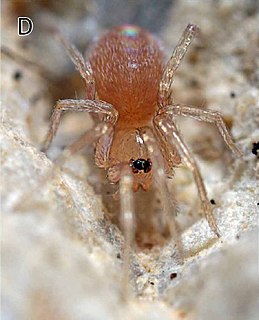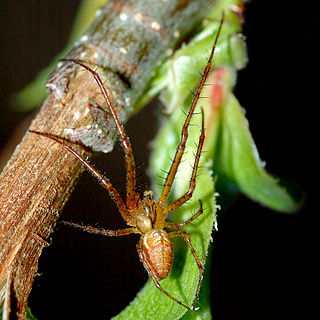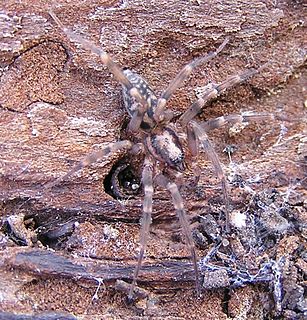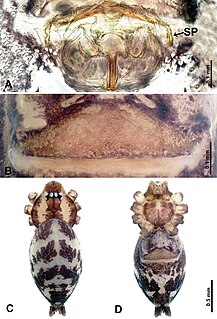
The family Dipluridae, known as curtain-web spiders are a group of spiders in the infraorder Mygalomorphae, that have two pairs of booklungs, and chelicerae (fangs) that move up and down in a stabbing motion. A number of genera, including that of the Sydney funnel-web spider (Atrax), used to be classified in this family but have now been moved to Hexathelidae.

Uloboridae is a family of non-venomous spiders, known as cribellate orb weavers or hackled orb weavers. Their lack of venom glands is a secondarily evolved trait. Instead, they wrap their prey thoroughly in silk, cover it in regurgitated digestive enzymes, and then ingest the liquified body.

Theridiidae, also known as the tangle-web spiders, cobweb spiders and comb-footed spiders, is a large family of araneomorph spiders first described by Carl Jakob Sundevall in 1833. This diverse, globally distributed family includes over 3,000 species in 124 genera, and is the most common arthropod found in human dwellings throughout the world.

Ground spiders comprise Gnaphosidae, the seventh largest spider family with nearly 2,000 described species in over 100 genera distributed worldwide. There are 105 species known to central Europe, and common genera include Gnaphosa, Drassodes, Micaria, Cesonia, Zelotes and many others. They are closely related to Clubionidae. At present, no ground spiders are known to be seriously venomous to humans.

Oonopidae, also known as goblin spiders, is a family of spiders consisting of over 1,600 described species in about 113 genera worldwide, with total species diversity estimated at 2000 to 2500 species. The type genus of the family is OonopsKeyserling, 1835.

Linyphiidae is a family of very small spiders comprising 4667 described species in 618 genera worldwide. This makes Linyphiidae the second largest family of spiders after the Salticidae. The family is poorly known; new genera and species are still being discovered throughout the world. The newest such genus is Yuelushannus from China, formally described in May 2020. Because of the difficulty in identifying such tiny spiders, there are regular changes in taxonomy as species are combined or divided.

Long-jawed orb weavers or long jawed spiders (Tetragnathidae) are a family of araneomorph spiders first described by Anton Menge in 1866. They have elongated bodies, legs, and chelicerae, and build small orb webs with an open hub with few, wide-set radii and spirals with no signal line or retreat. Some species are often found in long vegetation near water.

Liocranidae is a family of araneomorph spiders first described by Eugène Simon in 1897. They are one of several groups called "sac spiders". The holarctic genus Agroeca is the best-known, but it also includes various genera of more obscure spiders that still lack a diagnosis. Two species in the North American genus Neoanagraphis are found in the extremely dry conditions in the Mojave, Sonoran and Chihuahuan deserts. Females live in animal burrows while males wander and are the ones most often caught in pitfall traps.

Corinnidae is a family of araneomorph spiders, sometimes called corinnid sac spiders. The family, like other "clubionoid" families, has a confusing taxonomic history. Once it was a part of the large catch-all taxon Clubionidae, now very much smaller. The original members of the family are apparently similar only in that they have eight eyes arranged in two rows, conical anterior spinnerets that touch and are generally wandering predators that build silken retreats, or sacs, usually on plant terminals, between leaves, under bark or under rocks.

Scaffold web spiders (Nesticidae) is a family of araneomorph spiders closely allied with tangle web spiders. Like the "Theridiidae", these spiders have a comb of serrated bristles on the hind tarsi that are used to pull silk bands from the spinnerets. It contains 16 genera and about 300 species, many of which are associated with caves or overhangs. The genus Nesticus is the type for the family and is found throughout the world. The related Eidmannella has speciated considerably in Texas caves and includes some extremely localized species that are considered threatened. One species, Eidmannella pallida, is found in caves and under overhangs, but also in agricultural fields and other habitats away from such restricted areas. The genus Carpathonesticus is found in central Eurasia.

The ray spiders (Theridiosomatidae) are a family of spiders first described by Eugène Simon in 1881. They are most recognizable for their construction of cone-shaped webs.

Telemidae, also known as long-legged cave spiders, is a family of small haplogyne spiders. Most are cave dwelling spiders with six eyes, though some do not have any eyes at all. There are about 85 described species in ten genera.

Tetrablemmidae, sometimes called armored spiders, is a family of tropical araneomorph spiders first described by Octavius Pickard-Cambridge in 1873. It contains 126 described species in 29 genera from southeast Asia, with a few that occur in Africa and Central and South America. Pacullidae was incorporated into this family in 1981, but was later restored as a separate family in a 2016 phylogenetic study.

Symphytognathidae is a family of spiders with 73 described species in eight genera. They occur in the tropics of Central and South America and the Australian region. Exceptions include Anapistula benoiti, Anapistula caecula, and Symphytognatha imbulunga, found in Africa, Anapistula ishikawai, found in Japan, and Anapistula jerai, found in Southeast Asia.

Mysmenidae is a spider family with about 135 described species in thirteen genera. The family is one of the least well known of the orb-weaving spiders because of their small size and cryptic behaviour. These spiders are found in humid habitats such as among leaf litter and in caves.
Theotima is a genus of small spiders in the family Ochyroceratidae.

Caponiidae is a family of ecribellate haplogyne spiders that are unusual in a number of ways. They differ from other spiders in lacking book lungs and having the posterior median spinnerets anteriorly displaced to form a transverse row with the anterior lateral spinnerets. Most species have only two eyes, which is also unusual among spiders. A few species of Caponiidae variously have four, six or eight eyes. In some species the number of eyes will increase when the spiderling changes its skin as it grows towards adulthood.
Speocera is a genus of six eyed spiders in the family Ochyroceratidae, containing fifty one species.

Psilodercidae is a family of spiders first described as a subfamily of Ochyroceratidae by Machado in 1951 and raised to family rank by J. Wunderlich in 2008. These spiders can be distinguished by the "segestriid positioning" of their six eyes, the absence of leg bristles, strong apical bristles on the cymbium, and several pairs of spermathecae in females.

















